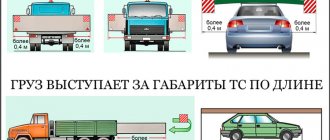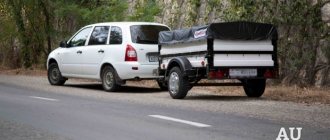What to carry?
The most convenient way to transport any of the devices mentioned is to place it in the back of a pickup truck or minivan. This way you are practically unlimited in speed, while with a trailer on the highway - up to 90 km/h and on a regular road - up to 70 km/h.
Without a trailer, aerodynamics are better and, accordingly, fuel consumption is lower. And the cross-country ability is higher, which is important in the “last mile” before the target. It is more convenient to secure cargo in the back of a pickup truck, since there are usually mounting eyes there. Some trailers, for example, do not have them. But if you can’t do without a trailer, pay attention to the following two points.
We are on Twitter:
Login Registration
Automotive news
Rules for the movement of heavy trucks in the automatic weight control zone have been adopted. The Federal Tax Service has approved the application form for the death or destruction of a vehicle. In Russia, it is forbidden to disembark children without a ticket from buses. A new sign 6.22 has been introduced in the traffic rules - “photo and video recording” Testing for alcohol dependence has been postponed for another year. The Ministry of Health has updated the requirements for completing car first-aid kits, the Ministry of Transport has approved the procedure and terms for storing diagnostic maintenance cards. Obtaining permission for international transport will now be done in a new way. You can now check your MTPL policy for authenticity online. The Central Bank has set new tariffs for MTPL.
/ Legal articles on automobile law / Traffic and safety issues / Rules for transporting goods on a passenger trailer
Rules for transporting goods on a passenger trailer
A trailer is a vehicle, not equipped with an autonomous engine, used for the transportation of goods in conjunction with a motor vehicle. A passenger trailer also belongs to a full-fledged vehicle, and therefore, its improper installation or operation can lead to a threat to the safety of road users.
Parameters of trailers for passenger cars
When driving with a trailer, the car plays the role of a tractor, and the trailer is attached to it using a rigid connecting element - a towbar, which is equipped with electrical wiring and a plug socket. The trailer is equipped with lighting devices: turn signals, brake lights, side lights.
For any type of vehicle, the maximum permissible weight of a loaded trailer is established. If this value is less than 750 kg, then the driver can drive with category “B” (categories “C” and “D” are also allowed). It is allowed to use a trailer with all vehicles of category “B”; its weight should not exceed the weight of the car.
When choosing a trailer, you need to take into account the intended scope of its use. The following types of operation are most typical for passenger cars:
— It is planned to transport building materials, furniture, and use them for other household needs;
— Transportation of snowmobiles, hydro- and ATVs;
Driving with a trailer
When overtaking and braking, it should be taken into account that the presence of a trailer causes a decrease in acceleration dynamics and an increase in braking distance, therefore:
— Braking should be done smoothly, even when there is no load;
— It is necessary to keep a distance from the car in front, and when you need to slow down, you need to do it gradually;
— If you need to turn, you need to start slowing down in advance; turns are driven “pull”. You need to brake without jerking, as this leads to the trailer and the car skidding or “folding”, since when turning, the radius of movement of the trailer wheel is less than the radius of the tractor wheel;
— Maneuvering, changing lanes in traffic and parking are difficult, especially within the city. Particular care is required when driving in reverse, especially with a trailer with a high awning. At increased speed and too much cargo, the trailer begins to swing to the sides;
The amount of fuel consumed when driving with a trailer does not increase noticeably. Typically, the increase in consumption is 5-15% depending on travel conditions and cargo weight (the higher the weight, the higher the consumption).
Paperwork
The trailer must be registered with the traffic police as an independent vehicle, receiving a separate certificate and license plate.
If the owner of the trailer is an individual, its technical inspection is not considered a mandatory procedure; this is only necessary for organizations.
At the request of the traffic police officer, the driver of the car, together with the documents for the car, is obliged to provide registration documents for the trailer.
Travel speed with a trailer and methods of marking the load
In accordance with traffic regulations, the maximum permissible speed for driving with trailers, compared to driving without trailers, is reduced by 20 km. and amounts to:
— 70 km/h on regular roads;
— 90 km/h – on highways;
The distance from the top of a loaded trailer to the road surface should not exceed 4 m, the width of the load cannot be more than 2.55 m. The load at the rear is not allowed to protrude more than 2 m.
If the load protrudes beyond the dimensions of the vehicle by 1 m in front and behind, or by 0.4 m on the side of the side light, it is necessary to install the “Large Load” sign. In addition, at night or in case of poor visibility, red lanterns or reflectors are installed behind, and a white lantern or reflector is installed in front.
If the dimensions are exceeded, the tractor must be equipped with rear-view mirrors on extended brackets.
Download Features
It is prohibited to transport people on cargo trailers or caravan trailers. The weight of the load and its distribution along the axes should not exceed the volumes established during manufacture.
The driver’s responsibilities include placing, securing and securing the cargo so that it does not fall out while driving and does not create interference for road users.
When placing the load, it is necessary to ensure its uniform distribution, and the center of gravity must fall on the axle (if the trailer is single-axle) or axles (if the trailer is two-axle):
If the center of gravity moves forward, the load is placed on the hitch point and the rear of the vehicle, resulting in reduced traction between the front wheels and the road.
If the center of gravity is shifted rearward, it causes the rear of the vehicle to lift and reduce traction between the rear wheels and the road.
The load should not block the driver's view, interfere with control, or disrupt the stability of the vehicle; lighting devices should not obscure hand signals. In addition, the cargo must not pollute the environment.
Be sure to carry chocks (2 pieces) with you to install under the wheels when stopping on sections of the road with a slope.
Before driving, it is the driver’s responsibility to check the technical condition of the vehicle, in particular:
— Checking the presence of lubrication on the tow bar;
— Check for play between the coupling ball and the assembly. If play is detected, it must be eliminated;
— Checking the tire pressure level;
— Checking the reliability of the connection between the safety rope and the chain;
-Checking lighting devices;
It is prohibited to drive if there is a malfunction of the brake or clutch system, a problem with the steering, a malfunction of the headlights and side lights, or a windshield wiper on the driver’s side.
During the journey, the driver is also obliged to ensure that the vehicle is in good working order in full compliance with the rules of safe movement. It is prohibited to make changes to the design of the trailer without the approval of the traffic police.
That's all, good luck on the roads!
Vehicles of category M1
Vehicles not subject to categorization
trailer
18196
No comments yet. Yours will be the first!
Write a comment
New comments
Badyrgy → Removal and expungement of a criminal record under Art. 264.1 of the Criminal Code of the Russian Federation 5 days ago
Convicted in 2014 of Part 1 of Article 264 of the Criminal Code of the Russian Federation with restriction of freedom and deprivation of rights for 1 year. How to expunge a criminal record? And where to go
Vladimir → Is it necessary to give way to a bus leaving the bus stop... 20 days ago
The rules state that the driver must give way to a bus departing from a stop within the city limits, but I drive at a speed of 60 km per hour at the main speed...
Automotive Lawyer → Deprivation of the right to drive under Art. 264 of the Criminal Code of the Russian Federation. About the most... 1 month ago
Hello. The period of criminal punishment in the form of deprivation of the right to drive runs, regardless of whether the vehicle is passed or not. The traffic police have been punished for enforcing this...
Evgeniy → Deprivation of the right to drive under Art. 264 of the Criminal Code of the Russian Federation. About the most... 1 month ago
Good evening! In 2014, he was convicted under Part 264 of the Criminal Code and served a real sentence of 2 years in a penal colony; the court also deprived him of his license for 3 years, after...
Automotive Lawyer → Deprivation of the right to drive under Art. 264 of the Criminal Code of the Russian Federation. About the most... 1 month ago
Hello. The terms of deprivation under the article of the Code of Administrative Offenses of the Russian Federation and under the article of the Criminal Code of the Russian Federation are not cumulative. Each term is calculated independently, i.e., independently of each other
Category on driver's license
The vast majority of car owners in our country have a category B driver’s license, which allows them to drive vehicles with a gross weight not exceeding 3.5 tons. The Federal Law “On Road Safety” (Article 25) allows a driver with category B to drive category B vehicles with a trailer in two cases:
- the maximum trailer weight does not exceed 750 kg;
- the maximum mass of the trailer exceeds 750 kg, but does not exceed the unladen mass of the vehicle, provided that the total permissible maximum mass of such combination does not exceed 3500 kg.
The main stages of transporting an oversized boat
Transportation of yachts and boats by motor transport involves performing a number of preparatory works of a different nature. The entire transfer process includes several stages.
- Preparation of documentation, vessel insurance, calculation and approval of the route:
- Obtaining a permit requires the owner of the cargo to indicate its weight and dimensions; the client is responsible for providing incorrect information. These data are checked by the carrier; if they do not correspond to reality, a fine will be imposed on the owner of the vessel;
- Considering the specific characteristics of the cargo, it is advisable to take out insurance;
- When transporting to another country, additional documentation is required, including customs documentation. Permission is required from the authorities of each country through whose territory the transfer is carried out;
- When concluding an agreement with a carrier, you can also issue a power of attorney to the person carrying out the transportation, which is especially important in the case of an international transfer;
- The route is carefully planned and coordinated with government authorities. After all formalities have been completed, the vessel must be prepared for transfer.
- Preparing a watercraft for transportation:
- All protruding parts, glass elements, antennas, etc. are removed from the boat;
- All loose furniture and appliances are also removed;
- Electrical appliances and batteries are turned off;
- Water and fuel are drained, drain plugs are removed;
- Doors, hatches, windows are sealed;
- Masts and sails are also removed if we are talking about a sailing yacht.
- Loading onto a vehicle:
- Boats or yachts are loaded onto the platform using special equipment, as well as soft slings and traverses, since the hull of the vessel on land can easily be damaged;
- What follows is the procedure for securing the object with straps and special fixing mechanisms, which should be given great attention, since the stability of the watercraft does not differ. The reliability of the fixation is carefully checked so that the vessel is not damaged in any way during movement, and even more so does not go into free “sailing” at the next turn;
- Placing a small boat on a trailer also requires reliable fastening with proper load distribution. The best option in the case of a small boat would be to use special boat trailers adapted for this task, which also have the appropriate fastenings and equipment. When transporting even a small boat on your own, weight compliance must be observed. That is, the weight of the boat should not exceed the permissible weight of the trailer;
- To preserve its appearance, the vessel is packed in a special case of suitable size and covered with a tarpaulin and shrink film;
- When transporting oversized cargo, a special sign is installed on the tractor; in addition, the trawl is equipped with a beacon that notifies other road users about the transportation of cargo of non-standard sizes.
- Transportation:
- Movement with the participation of cover vehicles is required if the width of the road train is over 3.5 meters and length - 24 meters. Additional escort by a traffic police patrol car is carried out if the width of the vessel exceeds 4 meters and length - 30 meters;
- The driver is obliged to reduce speed to the minimum permissible, in accordance with the rules of the road, when turning and crossing intersections;
- Every 4 hours, the vehicle is expected to stop in order to check the reliability of the fastenings, since this type of cargo is not stable.
- Unloading:
- Upon arrival at the destination, the ship is carefully inspected for damage;
- Unloading is also carried out using special means, after which the object is launched into the water and tested.
Let's take it in tow
16 questions about car trailers
1) What license do you need to drive with a trailer?
According to the current legislation, a license with category “B” is sufficient if the permitted maximum weight of the towed trailer does not exceed 750 kg. Or if the permitted maximum weight of the trailer does not exceed the weight of a curb vehicle belonging to category “B”, and the permitted maximum weight of such a combination of vehicles does not exceed 3,500 kg.
In the event that a trailer or a “vehicle+trailer” combination does not fit into this framework, you will have to open an additional “E” category in your license. On average in St. Petersburg, the cost of training will be 8,000-10,000 rubles, the duration of training is about one and a half months.
2) Can the trailer be used with any vehicle?
Yes, if its permissible maximum weight does not exceed the curb weight of a vehicle belonging to category “B”. As for the trailer unit - the tow bar, technically it can be installed on any car.
3) How do I need to retrofit my car to use a trailer?
This, as already mentioned, is the installation of a tow bar, as well as the installation of additional electrical wiring for the lighting devices (dimensions, turn signals and brake lights) of the trailer.
4) What parameters are used to select a trailer for a car?
First of all, you need to answer the question: what do you need a trailer for - to transport boards and bricks, a jet ski or a boat? Or maybe a mobile country house? Next, we carefully read the technical characteristics of the trailer and evaluate whether the future composition fits into category “B” or not.
It would also be a good idea to read the instructions for your car, where there is a clause “maximum weight of a towed trailer equipped/not equipped with brakes.” You can search for this information on the Internet or call your dealer. After that we make a choice.
5) What are the features of driving with a trailer?
In fact, a trailer, especially a loaded one, significantly reduces the acceleration dynamics of the car and increases the braking distance. This must be taken into account when braking and overtaking.
You need to brake smoothly - regardless of whether the trailer is empty or loaded. It is important to maintain a distance from the car in front. Before turning, it is better to reduce the speed in advance and go through it “pull”. Jerky braking, especially when cornering, can cause the trailer or car to skid and “collapse.”
At high speeds, the trailer is prone to swaying from side to side. According to traffic regulations, the maximum speed of a passenger car with a trailer outside populated areas on highways should not exceed 90 km/h, on other roads – 70 km/h.
When driving with a trailer, changing lanes in traffic, maneuvering and parking in urban conditions becomes much more difficult. Reversing is especially difficult. At the same time, a large trailer impairs rear visibility.
So, in the interior mirror, for example, you can no longer see anything except your own caravan trailer. True, if necessary, you can install additional, so-called caravan, rearview mirrors. They are installed either on the hood of the car or on the standard rearview mirrors. With trailers with a large body area - such as a caravan or a cargo trailer - you need to be careful when driving in strong winds.
6) How to load a trailer correctly?
The load should be placed evenly - so that its center of gravity is above the axle (if there is one) or between the axles of the trailer. Shifting the center of gravity forward will place unnecessary stress on the towbar and the entire rear of the vehicle, reducing the traction of the steering wheels.
Moving rearward will cause the rear of the vehicle to lift, reducing rear wheel traction. In this case, the center of gravity of the transported cargo should be as low as possible, since the higher it is, the more prone the trailer is to longitudinal and lateral swing, which impairs handling.
7) Can the load extend beyond the dimensions of the trailer?
According to ch. 23 of the Russian Federation Traffic Regulations, the load should not protrude from the rear by more than 2 m, the width should not be more than 2.55 m, and the height of the trailer with the load should not be more than 4 m from the surface of the roadway.
In this case, cargo protruding beyond the dimensions of the vehicle in front and behind by more than 1 m (or on the side by more than 0.4 m from the outer edge of the side light) must be marked with identification signs “Large cargo”, and in the dark and in conditions insufficient visibility, in addition, in front - a flashlight or a white reflector, at the rear - a flashlight or a red reflector.
 What can't be transported in a trailer?
What can't be transported in a trailer?
First of all, whom: people. Including in a caravan trailer. It is not allowed to transport explosive and flammable substances. These de jure include both a canister of gasoline and a household gas cylinder. However, de facto everyone carries them, and traffic police inspectors don’t find fault. But if there is a whole warehouse of fuel and lubricants in the trailer, the inspector can stop legally.
In addition, as prescribed in clause 23.3. Traffic regulations of the Russian Federation, the load must not limit visibility, interfere with control, disrupt the stability of the vehicle, cover external lighting devices and reflectors, registration and identification marks, and also not interfere with the perception of hand signals. Also, the cargo should not create noise, create dust, or pollute the road or the environment.










